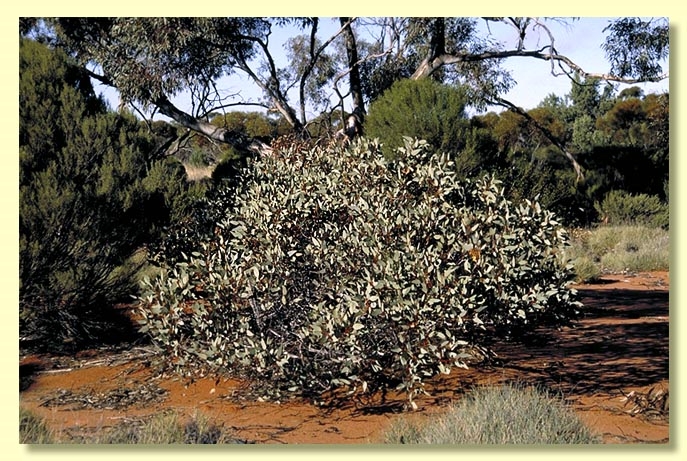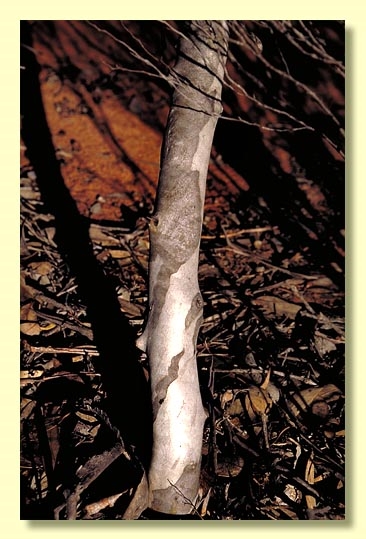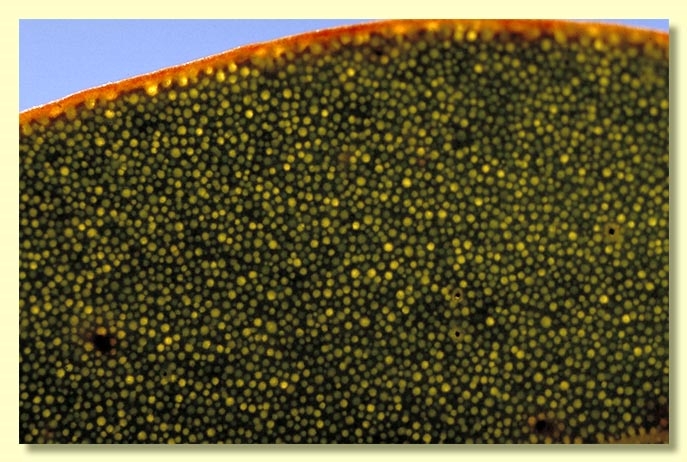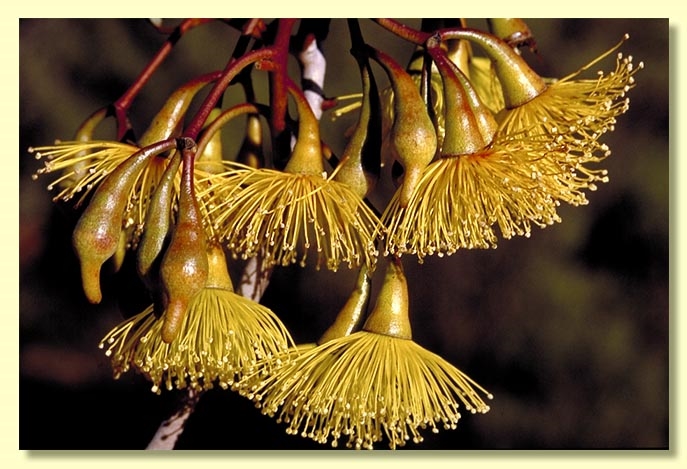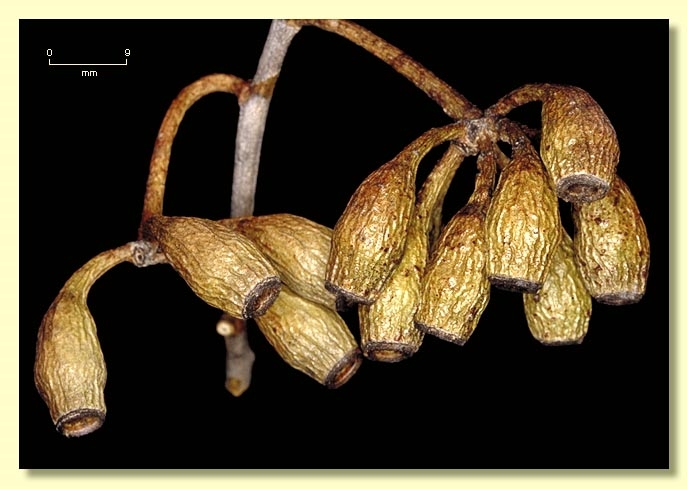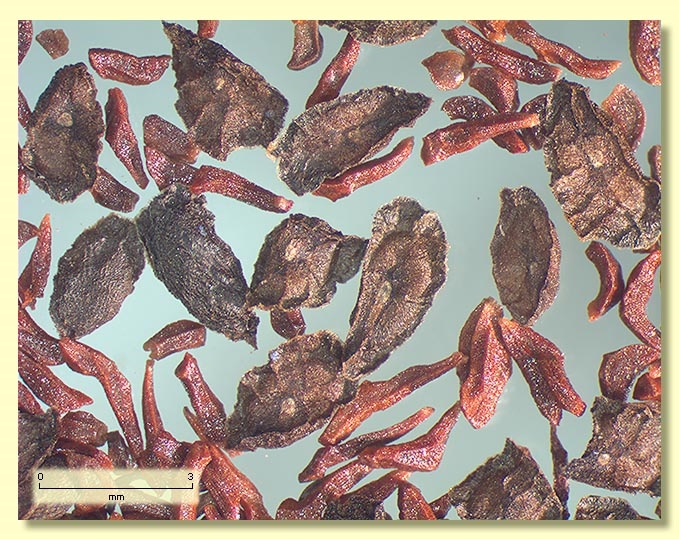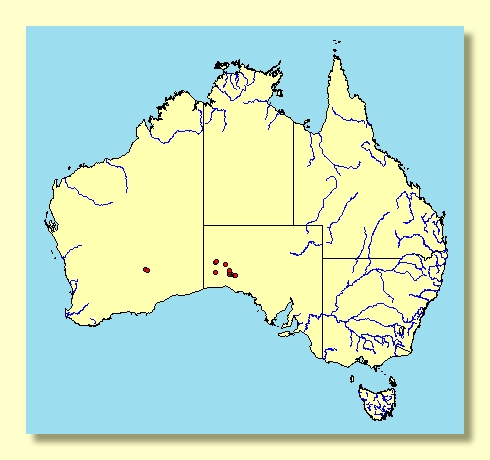Euclid - Online edition
Eucalyptus pimpiniana
Eucalyptus | Symphyomyrtus | Dumaria | Dissonae
T: E of Ooldea, N of Fowler's Bay, S.A., June 1909, H.Deane s.n.; holo: NSW; iso: K.
Eucalyptus isingiana Maiden, Crit. Revis. Eucalyptus 6: 353 (1922). T: 407 miles [c. 650 km] from Port Augusta, near Ooldea, S.A., 5 Sept. 1920, E.H.Ising 1480; holo: NSW.
Bark smooth throughout, sometimes powdery, mottled salmon, pink, white, pale grey and brown.
Branchlets have oil glands in the pith.
Juvenile growth (coppice or field seedlings to 50 cm): stems rounded in cross-section; juvenile leaves alternate, petiolate, ovate to lanceolate, 6–8 cm long, 2.5–4 cm wide, base tapering, greenish grey.
Adult leaves alternate, petioles 1.5–2.5 cm long; blade lanceolate to broadly lanceolate, 6.5–14 cm long, 1.7–3.3 cm wide, base tapering to petiole, concolorous, thick, dull, blue-green to blue-grey or glaucous, side-veins usually obscured by oil glands, reticulation apparently absent, intramarginal vein rarely visible, oil glands very numerous.
Inflorescence axillary unbranched, peduncles always pendulous, (0.8)1.8–3(3.7) cm long, buds 9 to ?15, pedicellate, pedicels 0.6–1.3 cm long. Mature buds narrowly obovoid to pyriform (2–3.3 cm long, 0.7–1 cm wide), sometimes longitudinally ridged, scar present, operculum with a long beak (1.1–1.5 cm long), stamens inflexed, anthers oblong, versatile, dehiscing by lateral slits (non-confluent), style long, stigma blunt to tapered, locules usually 3, the placentae each with 4 vertical ovule rows. Flowers yellow.
Fruit pendulous, pedicellate, pedicels 0.5–1.2 cm long, cylindrical to barrel-shaped, 1.4–2 cm long, 0.9–1.2 cm wide, sometimes longitudinally ridged, disc descending, valves usually 3, enclosed.
Seeds grey-brown, 3–5 mm long, distorted-cuboid to ovoid with ridges on the sides, a conspicuous marginal flange, hilum more or less ventral.
Cultivated seedlings (measured at ca node 10): cotyledons reniform; stems rounded in cross-section; leaves always petiolate, opposite for 3 or 4 nodes then becoming alternate, ovate to lanceolate, 7–9 cm long, 2.5–5 cm wide, dull, dark green.
Flowering has been recorded in January, July and October.
A low, straggly mallee of disjunct occurrence on sand dunes in the Great Victoria Desert of South Australia and Western Australia, from Ooldea and Immarna west to Mulga Rock and near Lake Minigwal.. The stems are smooth, branchlets have pith glands, the adult leaves are broad, dull, grey to green-grey and the buds prominently beaked.
Eucalyptus pimpiniana belongs in Eucalyptus subgenus Symphyomyrtus section Dumaria because the buds have two opercula, ovules are in four rows on the placentae and cotyledons are reniform. E. pimpiniana is easily distinguished from any other species in the section by the obscure reticulation in the adult leaves and great density of oil glands. The inflorescences are pendulous and the buds elongated. The fruit slightly resemble those of E. incrassata and E. ceratocorys but are more elongated, up to 2.2 cm long. The seeds are also like those of the E. incrassata group of species generally but are flatter and with thin flanged edges.

